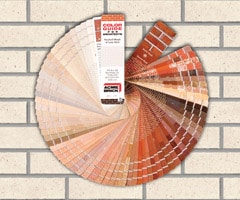
Whether brick is used as a load-bearing structural element or merely as a decorative/protective veneer, New York architects have many creative ways to alter the appearance of a brick façade. Designers can select different types, colors, textures and sizes – and then specify different patterns for laying the courses.
Types: Common brick and facing brick are the main types; facing brick has been manufactured for its aesthetic qualities – color and surface texture. Facing brick is further typed by degree of uniformity in color and lack of chips, cracks, etc. (We’re ignoring other special types such as firebrick that don’t contribute to a building’s overall appearance.)
Colors: Bricks (and the mortar holding them together) can be ordered in hundreds of different colors. Architects can mix colors – either randomly or in distinct patterns – to create different visual textures. (The use of several colors in architecture is called “polychrome.”)
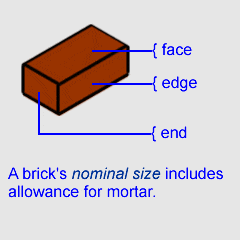
Textures: The manufacturing method and clay type determine a brick’s surface texture, which could be rough, smooth or even shiny (glazed). In addition, bricks can be given a patterned surface (like the milled edge of a quarter).
Nominal sizes: The modular brick is just one of three named sizes that are 2-2/3 inches thick (three courses = 8 inches); Norman brick is 4 x 2-2/3 x 12 inches, SCR brick is 6 x 2-2/3 x 12 inches. Two sizes are 3-1/5 inches thick (5 courses = 16 inches); engineered brick is 4 x 3-1/5 x 8 inches, Norwegian brick is 4 x 3-1/5 x 12 inches. Roman brick is 4 x 2 x 12 inches (4 courses = 8 inches). Economy* brick is 4 x 4 x 8 inches (2 courses = 8 inches). Nominal size is slightly larger than the brick’s actual physical size, to allow for the thickness of the mortar joint. Because the mortar joints are a uniform thickness, brick size affects the mortar/brick ratio – and thus, appearance.
* “Economy” because it takes less mortar and labor to use thicker bricks: For a 10-foot-tall wall, modular brick requires 45 courses, economy brick needs only 30 courses.
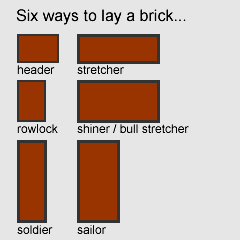
Orientation: There are six basic ways to lay a brick. Viewed from the face of the wall, a brick laid:
- horizontally on its face with the edge exposed is a stretcher
- horizontally on its face with the end exposed is a header
- horizontally on its edge with the face exposed is a shiner or bull stretcher
- horizontally on its edge with the end exposed is a rowlock or rollock
- vertically on its end with the edge exposed is a soldier
- vertically on its end with the face exposed is a sailor
And just to make things more interesting, bricks can be corbelled (projected from the wall surface) or angled (to give a toothed appearance) or gauged (shaped) to a non-rectangular profile, as in an arch.
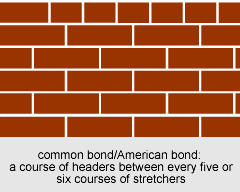
Bond: The overlap pattern adds another element of variety. The most common pattern is running bond or stretcher bond – stretchers that overlap the course below by half. Add a course of headers after every five or six courses of stretchers and you get American bond. Alternating courses of headers and stretchers are called English bond. Alternating headers and stretchers in the same course (with headers centered on stretchers above and below) are called Flemish bond. Other bonds have more complex patterns, often accentuated by contrasting-colored bricks or by corbelling.
Architects’ artistic preferences, alas, may be shackled by accountants: Thinner bricks require more mortar and labor per foot of elevation than thick bricks; complex patterns likewise take more labor (and may take more bricks) than simple common bond or American bond.
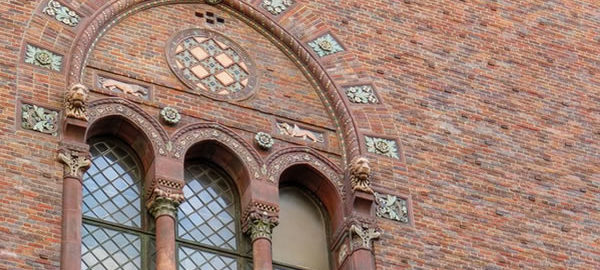
![IMG_0388_89_90Adjust [2/19/2012 1:37:48 PM] IMG_0388_89_90Adjust [2/19/2012 1:37:48 PM]](https://www.newyorkitecture.com/wp-content/gallery/painting-with-bricks/img_0388_89_90adjust.jpg)
![Z_IMG_8023_4_5Adjust [2/6/2012 12:27:37 PM] Z_IMG_8023_4_5Adjust [2/6/2012 12:27:37 PM]](https://www.newyorkitecture.com/wp-content/gallery/painting-with-bricks/z_img_8023_4_5adjust.jpg)
![P9140134 [9/14/2011 3:11:12 PM] P9140134 [9/14/2011 3:11:12 PM]](https://www.newyorkitecture.com/wp-content/gallery/painting-with-bricks/p9140134.jpg)
![P9140056 [9/14/2011 1:54:58 PM] P9140056 [9/14/2011 1:54:58 PM]](https://www.newyorkitecture.com/wp-content/gallery/painting-with-bricks/p9140056.jpg)
![P8020046 [8/2/2011 12:48:51 PM] P8020046 [8/2/2011 12:48:51 PM]](https://www.newyorkitecture.com/wp-content/gallery/painting-with-bricks/p8020046.jpg)
![K_IMG_8809_10_11Adjust [2/7/2012 12:37:17 PM] K_IMG_8809_10_11Adjust [2/7/2012 12:37:17 PM]](https://www.newyorkitecture.com/wp-content/gallery/painting-with-bricks/k_img_8809_10_11adjust.jpg)
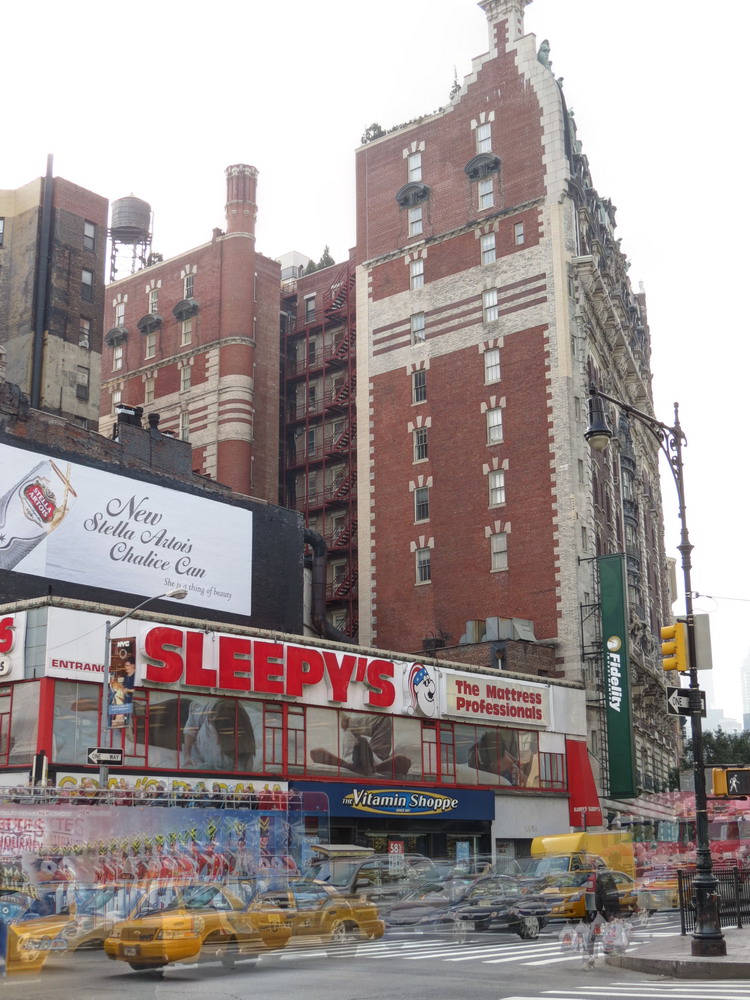
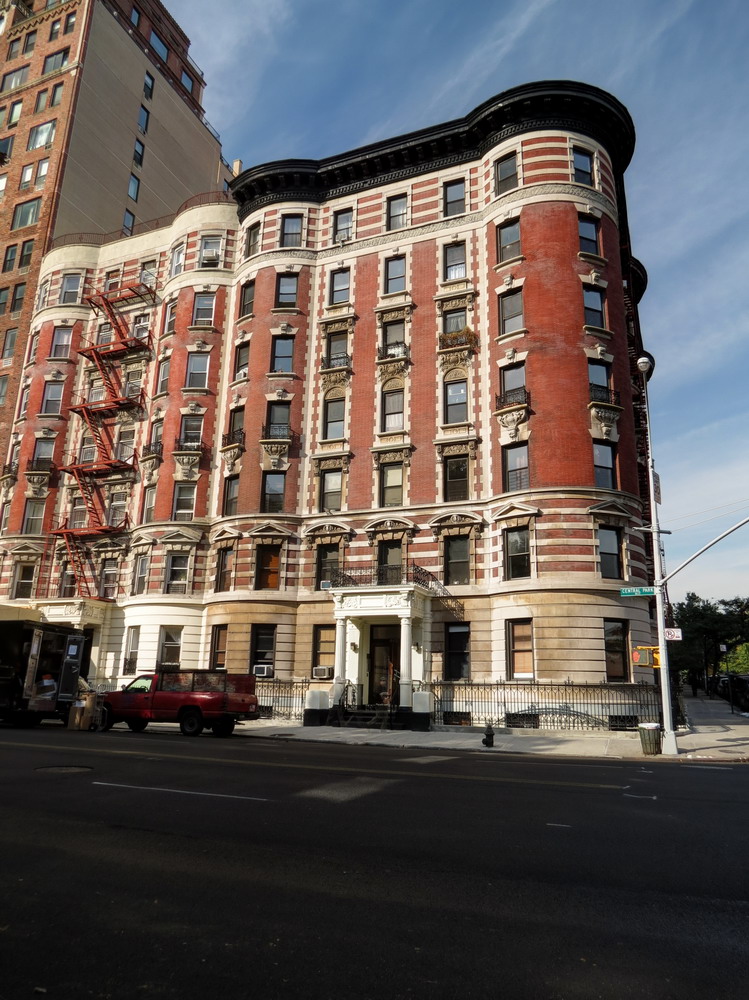
![IMG_0836 [9/30/2011 1:05:36 PM] IMG_0836 [9/30/2011 1:05:36 PM]](https://www.newyorkitecture.com/wp-content/gallery/painting-with-bricks/img_0836.jpg)
![IMG_0707_8_9Adjust [12/1/2011 12:43:17 PM] IMG_0707_8_9Adjust [12/1/2011 12:43:17 PM]](https://www.newyorkitecture.com/wp-content/gallery/painting-with-bricks/img_0707_8_9adjust.jpg)
![IMG_0547_8_9Adjust [2/19/2012 2:36:35 PM] IMG_0547_8_9Adjust [2/19/2012 2:36:35 PM]](https://www.newyorkitecture.com/wp-content/gallery/painting-with-bricks/img_0547_8_9adjust.jpg)
![A_2638_39_40Adjust [10/10/2011 10:34:47 AM] A_2638_39_40Adjust [10/10/2011 10:34:47 AM]](https://www.newyorkitecture.com/wp-content/gallery/painting-with-bricks/a_2638_39_40adjust.jpg)
![E_IMG_7483_4_5Adjust [2/5/2012 1:08:44 PM] E_IMG_7483_4_5Adjust [2/5/2012 1:08:44 PM]](https://www.newyorkitecture.com/wp-content/gallery/painting-with-bricks/e_img_7483_4_5adjust.jpg)
![Doors of Brooklyn: d29 [] Doors of Brooklyn: d29 []](https://www.newyorkitecture.com/wp-content/gallery/painting-with-bricks/d29.jpg)
![D_IMG_8374_5_6Adjust [2/6/2012 2:38:39 PM] D_IMG_8374_5_6Adjust [2/6/2012 2:38:39 PM]](https://www.newyorkitecture.com/wp-content/gallery/painting-with-bricks/d_img_8374_5_6adjust.jpg)
![C_IMG_8899_900_901Adjust [2/7/2012 1:02:04 PM] C_IMG_8899_900_901Adjust [2/7/2012 1:02:04 PM]](https://www.newyorkitecture.com/wp-content/gallery/painting-with-bricks/c_img_8899_900_901adjust.jpg)
![C_IMG_8896_7_8Adjust [2/7/2012 1:00:54 PM] C_IMG_8896_7_8Adjust [2/7/2012 1:00:54 PM]](https://www.newyorkitecture.com/wp-content/gallery/painting-with-bricks/c_img_8896_7_8adjust.jpg)
![C_4932_3_4Adjust [10/28/2011 12:50:50 PM] C_4932_3_4Adjust [10/28/2011 12:50:50 PM]](https://www.newyorkitecture.com/wp-content/gallery/painting-with-bricks/c_4932_3_4adjust.jpg)
![C_4929_30_31Adjust [10/28/2011 12:50:25 PM] C_4929_30_31Adjust [10/28/2011 12:50:25 PM]](https://www.newyorkitecture.com/wp-content/gallery/painting-with-bricks/c_4929_30_31adjust.jpg)
![B_IMG_7261_2_3Adjust [2/5/2012 12:02:22 PM] B_IMG_7261_2_3Adjust [2/5/2012 12:02:22 PM]](https://www.newyorkitecture.com/wp-content/gallery/painting-with-bricks/b_img_7261_2_3adjust.jpg)
![B_2671_2_3Adjust [10/10/2011 10:44:00 AM] B_2671_2_3Adjust [10/10/2011 10:44:00 AM]](https://www.newyorkitecture.com/wp-content/gallery/painting-with-bricks/b_2671_2_3adjust.jpg)